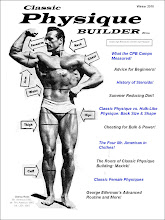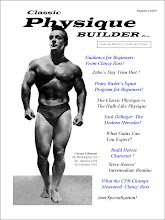
(photo above - Alan Stephan, Mr. America 1946)
Are you an absolute beginner? Would you like to build a classic physique? Are you confused by all the mainstream muscle mags as to what kind of routine you should follow? Don't worry! We have a nice, absolute beginner's routine from the Golden Age of Classic Physique Building (the 1940s and 50s) that can help get you started! It was offered by Alan Stephan, Mr America 1946 in Joe Weider's Your Physique Magazine (Feb, 52 issue).
This routine is, what we would call today, an "abbreviated" routine - a very short workout of only 4 exercises - that is designed to get the absolute beginner started out in the right direction. The 4 exercises are compound (or basic) exercises which work multiple groups of muscles at the same time. This program was meant to be followed for 2 to 3 months prior to beginning a more comprehensive bodybuilding course.
If you have never lifted a weight before and have lived a sedentary life, then Alan recommended 3-4 weeks of conditioning doing walking, running, push ups, and deep knee bends before starting this program.
For this program, he recommended getting plenty of rest (9 hrs of sleep each night) and relaxation and a high protein diet consisting of meats, milk, and plenty of fruits and vegetables.
Alan said that you can see great improvements in a few weeks, in following such a program, but don't let anyone tell you that you will get a "Mr. America Physique" in a few months. It will take persistence, hard work, and following a good, comprehensive course of training.
But great things begin with the first few steps! So here is the program:
1. Bench Press, 8-12 reps, 1 set
2. Breathing Squats, 8-12 reps, 1 set
3. Bent Over Rows, 8-12 reps, 1 set
4. Press Behind Neck, 8-12 reps, 1et
Each exercise is to be done for 1 set. Pick a weight that allows you to complete only 8 reps. Then, each workout, try to increase your reps until you reach 12. When you can complete 12, then increase the weight at your next workout. Continue in this way for the course of the program. Do this program 3 days a week (e.g., M, W, F or T, Th, Sa),
For the bench press, make sure you have friends to act as "spotters". Or, these days, you can do bench presses on a Smith Machine where you can set the locks so that the bar will stop before hitting your chest.
For the breathing squats, between each squat, take 3 deep breaths. Breathing squats really kick up the metabolism and natural growth mechanisms!
For the bent over rows, keep the knees slightly bent and grasp the bar with a wide grip. Use a strict form.
For the press behind neck, perform it in a seated position. Warm-up your shoulders before hand and be careful not to use too much weight in the beginning until you know how much you can really handle.
Don't worry about doing multiple sets! By fighting to increase your reps and weights at each workout, you will be getting stronger and getting bigger. After 2 or 3 months, when you notice the gains (in strength and/or size) coming to a halt, then it will be time to switch to another beginner's program. There are many good beginner's programs to follow up Alan's Prep Routine (e.g., see Steve Reeve's beginning program by clicking on our "beginning workout routine" label on the sidebar) that will introduce you to the "set system" soon enough!
Also, don't worry that you are not doing direct exercises for each body part. The bench presses work your chest, shoulders, triceps, and even forearms. The breathing squats work your lower body. The bent over rows work your back and biceps. The press behind neck works your shoulders, triceps, and trapezius. So most of your body - and all the large muscle groups - are getting worked in this program!
CPB recommends starting a training log to keep track of your reps and poundages for each exercise. Don't rely on just your memory. It is critical, for making gains, to increase your reps and weights each workout if you can. So you really need to know what you did at your last workout. You need to be very systematic in your training. You don't want to be one of those who wonders around the gym, doing endless numbers of sets and reps, and getting nowhere. We are sure you want to use "Golden Age Methods to attain a Golden Age Physique!" - CPB
 (Photo above: Reg Park; Mr. Britain 1949; Mr. Europe 1950; Mr. Universe 1951; Mr. Universe - Pro 1958, 1965)
(Photo above: Reg Park; Mr. Britain 1949; Mr. Europe 1950; Mr. Universe 1951; Mr. Universe - Pro 1958, 1965)










